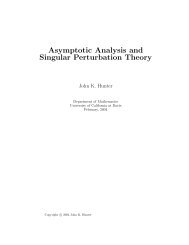The Riemann Integral
The Riemann Integral
The Riemann Integral
You also want an ePaper? Increase the reach of your titles
YUMPU automatically turns print PDFs into web optimized ePapers that Google loves.
36 1. <strong>The</strong> <strong>Riemann</strong> <strong>Integral</strong><br />
10<br />
8<br />
6<br />
4<br />
2<br />
0<br />
−2<br />
−4<br />
−2 −1 0 1 2 3<br />
Figure 7. Graphs of the exponential integral y = Ei(x) (blue) and its derivative<br />
y = e x /x (green) from Example 1.60.<br />
Example 1.60. <strong>The</strong> exponential integral Ei is a non-elementary function defined<br />
by<br />
∫ x<br />
e t<br />
Ei(x) =<br />
−∞ t dt.<br />
Its graph is shown in Figure 7. This integral has to be understood, in general, as an<br />
improper, principal value integral, and the function has a logarithmic singularity at<br />
x = 0 (see Example 1.83 below for further explanation). <strong>The</strong> exponential integral<br />
arises in physical applications such as heat flow and radiative transfer. It is also<br />
related to the logarithmic integral<br />
li(x) =<br />
∫ x<br />
by li(x) = Ei(lnx). <strong>The</strong> logarithmic integral is important in number theory, and it<br />
gives an asymptotic approximation for the number of primes less than x as x → ∞.<br />
Roughlyspeaking, thedensityofthe primesnearalargenumberxiscloseto1/lnx.<br />
Discontinuous functions may or may not have an antiderivative, and typically<br />
they don’t. Darboux provedthat everyfunction f : (a,b) → R that is the derivative<br />
of a function F : (a,b) → R, where F ′ = f at every point of (a,b), has the<br />
intermediate value property. That is, if a < c < d < b, then for every y between<br />
f(c) and f(d) there exists an x between c and d such that f(x) = y. A continuous<br />
derivative has this property by the intermediate value theorem, but a discontinuous<br />
derivative also has it. Thus, functions without the intermediate value property,<br />
such as ones with a jump discontinuity or the Dirichlet function, don’t have an<br />
antiderivative. Forexample, the function F in Example1.51isnot anantiderivative<br />
of the step function f on R since it isn’t differentiable at 0.<br />
In dealing with functions that are not continuously differentiable, it turns out<br />
to be more useful to abandon the idea of a derivative that is defined pointwise<br />
0<br />
dt<br />
lnt
















